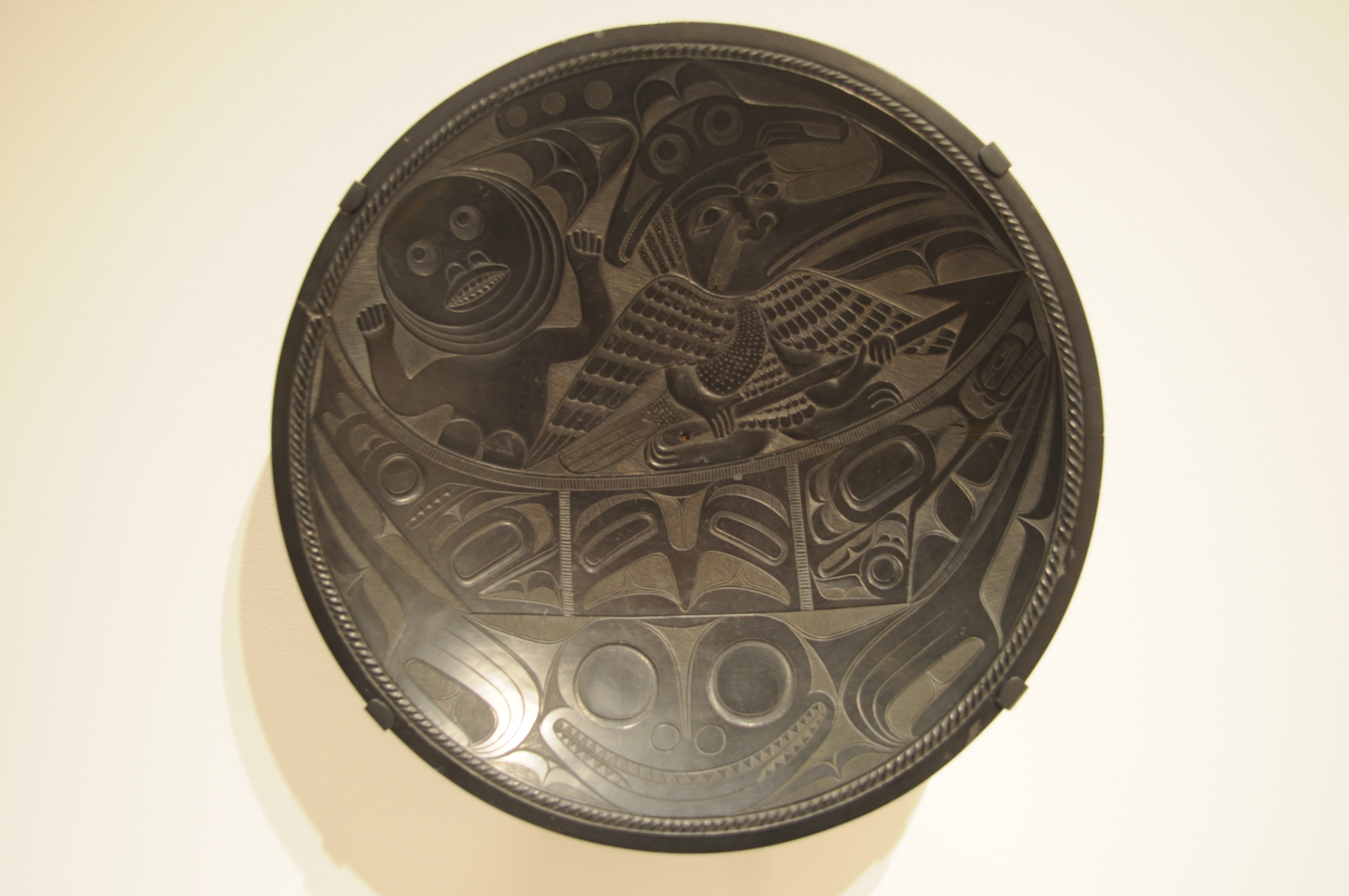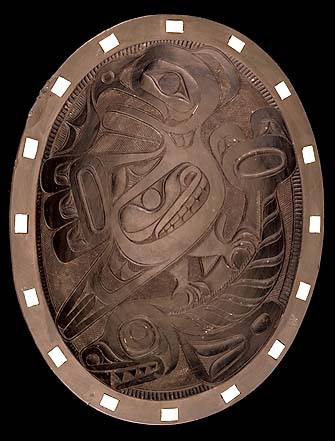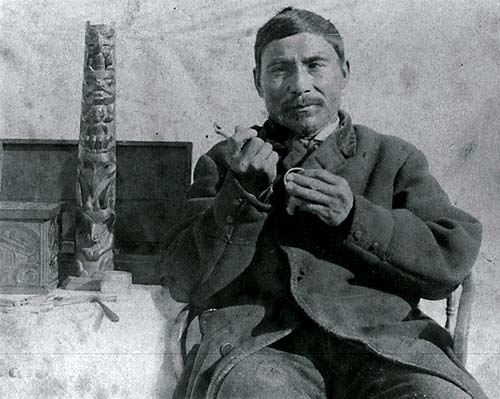Charles Edenshaw
Charles Edenshaw in Haida Idɨnsaw, (c. 1839 in Skidegate on Haida Gwaii (Queen Charlotte Islands ), † 1920, probably on 12 September, in Masset, British Columbia) was a chief of the Haida and is regarded as its principal carvers. He was also the most important model of Bill Reid, but also by John Marks, Isaac ( Ben ) Chapman and Daniel Stanley ( Skilgoldzo ), the grandson of Simeon Stiltla, a famous artist on Haida Gwaii. His work revolves around the myths of the Haida, like the raven.
Life
Idɨnsaw came from the Haida and was born into a traditional family, which had produced a number of Erbhäuptlingen. The Haida are composed of two Moietys. Only between them was to be married, not within the Moietys. The two Moietys in turn were divided into 22 or 23 lineages. The children remained in the maternal lineage. Idɨnsaws father's name was K'łajangk'una and belonged to Nikwən Qiwe Lineage of the Raven Moiety, his mother Qawkúna of the Sdəłdás Lineage to Eagle Moiety. She was the only sister of Chief Albert Edward Edenshaw. His first years were spent in Charles Kiusta on the north coast of Graham Iceland in the north west of the Queen Charlotte Islands. Well-being of his father he learned to carve canoes. About 1853 they moved slightly eastward to the village of kung where the family remained until about 1880. He survived the disastrous smallpox epidemic of 1862.
With about 14 years ago when he was sick, Idɨnsaw argillite and silver began to edit. Argillite was carved at least since the 1820s with the Haida, for example, smoking pipes produce. According to the Anglican priest Charles Harrison, who served in Masset, he was the first who worked precious metals. From these early works nothing is received, or can it not at least be assigned. Of the six totem poles that were assigned to him earlier, only four of him, two are from his uncle Eda'nsa.
In the 1870s, he carved two piles for Chief Skidegate, one of which was a home pile, the other was created in 1879-80 for the dead women of the chief. Between 1878 and 1881 Charles carved a memorial totem pole for Qwa'Kuna, John Robson he set. Prior to the ban of the potlatch (1885 ) he took at least ten times in such Verschenkfeierlichkeit with strict rituals in part, the ceremonial name - N ¿ ngkwigetklałs ( They gave ten Potlatch celebrations for him) - he received on the occasion of the last Potlatch his parents, indicated in any case out. On this occasion he was, hands, arms and legs tattooed on chest and back. Were shown frog, catfish and eagle, his daughter Florence Edenshaw Davidson recalls.
From his uncle Eda'nsa ( Albert Edward Edenshaw ) he was taken according to tradition at the age of 18 or 19 years to be. He was the Erbhäuptling the Lineage of Charles ' mother. His uncle had married for the second time in 1865 and Charles later married, in 1873, K'woiy ¿ ng, the cousin of the new woman. With K'woiy ¿ ng he lived alternately in Kung, Yatza and Masset. Shortly after 1880, the couple inherited a house in Masset from the widow of another uncle. On December 27, 1885, the two were baptized in Masset, where they assumed the name of Charles and Isabella. Immediately afterwards they were again, this time ecclesiastically married. About this time Charles Edenshaw was so successful that he no longer had to fish or hunt. His most productive phase spanned the three decades from 1880 to 1910. Through his descent, he rose in 1885 to chief (Chief Eda'nsa ). Despite the ban on central ceremonies such as the potlatch, by the Canadian government Edenshaw worked on his style and was designed by Charles Frederick Newcombe in 1902 as "the best living carvers ( carver ) in wood and stone " means.
The couple traveled extensively and sold his art in Port Essington, Fort Simpson, in Victoria and Juneau, Kasaan, Klinkwan and Ketchikan, Alaska. Charles ' wife Isabella turned her baskets and worked temporarily at a cannery. After the children had left the house, he could also work in their home in Masset. Among his works apart from totem poles and house crates, trays and drums, but also canoes, ritual masks and wooden headbands. These works of art were intended for sale. In addition, he painted the baskets and hats to his wife. His character was a star with four points, which are in two different colors. Silver and gold jewelry he made only for the rituals of the Haida; they were not for sale. The same was true for benches, cradles and stone grave monuments. In his other works, this is less clear, such as in carved walking sticks.
The sale took place mainly over the counter by George Cunningham in Port Essington, where also well-known collector traveled, among them Charles Newcombe. Of the eight children of the two Edenshaws had died five to 1896. This year also drowned her son Robert, he had been a promising carvers. The following year a daughter was born and baptized Florence, but the parents were disappointed that there was not a son. But it was the Father as the reincarnation of his mother. Two more daughters were born, one of which, however, died early.
1897 met Edenshaw in Port Essington, the ethnologist Franz Boas. He gave him the materials and drawings, which in 1927 published Boas in his work Primitive art. The designs of tattoos that he gave him, John Reed Swanton, published by the American Museum of Natural History in New York. For him Edenshaw produced 1901 models of eight totem poles, two house models, as well as a canoe. About his cousin Henry Edenshaw Swanton received in 1901 a mask.
Charles Edenshaws works are now widely scattered. They are predominantly located in the American Museum of Natural History, the Field Museum of Natural History in Chicago, the Burke Museum in Seattle, the Royal British Columbia Museum in Victoria, the Museum of Anthropology in Vancouver, the Canadian Museum of Civilization in Ottawa and the Pitt Rivers Museum in Oxford, England.
With the 1927 exhibition at the National Gallery of Canada in Ottawa, the later the gallery nationale du Jeu de Paume in Paris graced, Edenshaw gained world fame late. Marius Barbeau brought his unique position and the total carving by Haida carvers and his Haida myths from 1957 into the public consciousness. 1967 was the exhibition Arts of the Raven at the Vancouver Art Gallery, dedicated to 66 objects exclusively Edenshaw.
The best study provided 1981 Bill Holm. He pointed out the artistic development Edenshaws and marginalized them off towards contemporary art, such as his stepfather John Robson. After 1910 his eyesight Edenshaws subsided noticeably. According to his great-grandson Robert Charles Davidson is quoted as saying: " When I come back, I would never carve again. "










